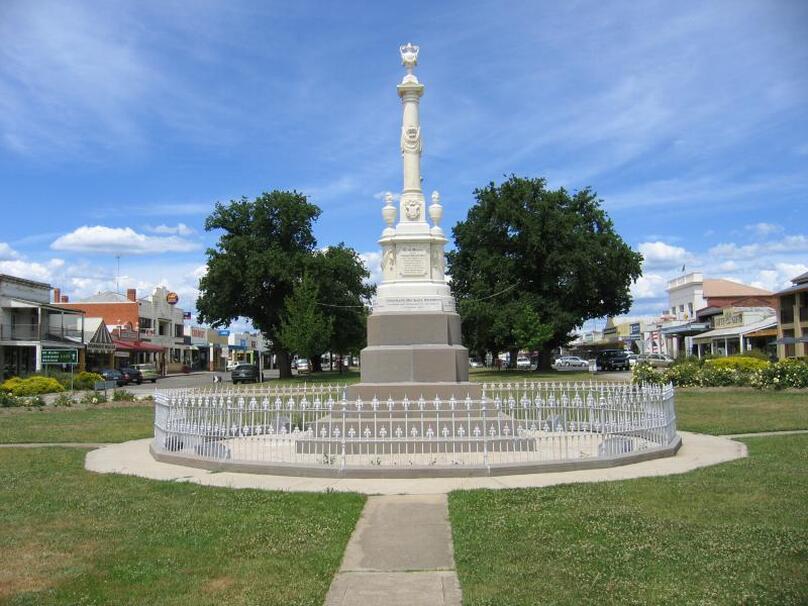Mansfield lies on the edge of the Southern Alps, famous for where the Kelly Gang killed three policemen.
Mansfield is a gracious town that lends itself to wide streets and historic buildings. Situated on Fords Creek in a valley at the foothills of the Great Dividing Range, it has become a resort town and popular winter base for skiers headed to Mount Buller & Mount Stirling. The beautiful and dramatic local scenery attracted filmmakers who used the surrounding countryside as the setting for the two 'Man From Snowy River' films!
Mansfield is situated 189km North-East of Melbourne via the Melba, Goulburn Valley & Maroondah Highways and is 316m above sea level.
Prior to the European settlement, the area was occupied by the Youngillim, or Wuywurrung Aboriginies who were part of the Kulin Nation. The first Europeans into the area were explorers William & Hovell in 1824 making their epic journey from New South Wales to Port Phillip.
Howqua Hills, now part of Parks Victoria, has a fascinating history. Pre-European settled at the Howqua River, which was used by Aboriginies as a major trade and war route. They had several quarries in the area where they dug out the hard Howqua greenstone which they used for spearheads, stone axes and cutting tools.
Gold was discovered in the valley in the 1860s and a major reef was located in the 1870s. Three large companies - Mountain Chief, Grand Rand & Howqua United - were established and the township of Howqua was proclaimed in 1888. There was a hotel, a post office, some boarding houses, a blacksmiths and a butcher.
Mining ceased in 1905 and Howqua was abandoned. Today, only a small number of relics remain from the gold mining days. Tunnel Bend is named after the 100m tunnel built in 1884 as a link between Howqua River and the 4km hand cut water race to the Hanney waterwheel at Sheepyard Flat. The tunnel entrance can still be seen and a brick chimney associated with a smelting furnace is still standing. Fry's Hut was built in the late 1930s by local bushman Fred Fry using split timber. Fry's life formed the basis of Nevil Shute's 1950 novel 'The Far Country' which was later filmed in the area.
Mansfield, originally known as Mount Battery, was at the boundary of a number of pastoral runs, and a township was surveyed in 1851 and named after Mansfield in Nottinghamshire, England. Settlement came after the discovery of gold nearby and the Post Office opened on 1 January 1858. The railway to Mansfield arrived in the town from Tallarook in 1891, being closed on November 18, 1978. The last passenger service was on May 28, 1977. The area around Mansfield named as Banbury was also the location of the novel The Far Country by Nevil Shute which featured logging on Mount Buller and previous forest fires, which having swept through Howqua obliterated almost all traces of a former settlement.
Mansfield is famous as part of the Ned Kelly Trail. Significant memorials include the Memorial to Police erected in the centre of the town's roundabout. Mansfield Cemetery is the burial ground for police officers slain by Ned Kelly and his gang at Stringybark Creek. Dr. John Pearson Rowe (1810–1878) was a physician and squatter who owned the 'Loyola Run' (also known as Mount Battery) near Mansfield. Reputed as the first Roman Catholic resident of the district, it is recorded that nearby Rochester was named after J. P. Rowe as he owned land on the Campaspe River. Rowe was a principal founder of the University of Melbourne. He fired a shot at a 14-year-old Ned Kelly accompanied by bushranger Harry Power in 1869. Rowe stood for the Upper House seat of the Murray District in 1859 and was defeated. In October 1878 Rowe supplied information to police Sergeant Kennedy on the whereabouts of Ned Kelly. Acting on Rowe's verified advice, Kennedy and his police party rode into the Wombat Ranges, where three of them were killed; and the Kelly Gang legend was born.
Mansfield is very close to two large lakes, Lake Eildon and Lake Nillahcootie. During the summer these sites are popular waterskiing destinations. The nearby Mount Buller and Mount Stirling offer attractions all year round. During winter they are visited for skiing, lifted and back country respectively. In the summer hiking and mountain biking are popular. Ski lifts operate year-round at Mount Buller allowing bikers to easily get to the top of downhill mountain biking runs. The bushland around Mansfield is used for horse riding, trail biking and four wheel driving on extensive tracks throughout the region.
Mansfield is home to 5,000 residents as well as over 500,000 visitors who travel to experience the beauty of the snow or the fresh country area home to many trees, kangaroos, wallabies, wombats, echidnas, possums, lizards and birds.
Welcome to High Country Mansfield!
_____________________________________________
Originally published on
2020 Aussie Towns.
(https://www.aussietowns.com.au/town/mansfield-vic)
Wikipedia.
(https://en.wikipedia.org/wiki/Mansfield,_Victoria)
Mansfield is a gracious town that lends itself to wide streets and historic buildings. Situated on Fords Creek in a valley at the foothills of the Great Dividing Range, it has become a resort town and popular winter base for skiers headed to Mount Buller & Mount Stirling. The beautiful and dramatic local scenery attracted filmmakers who used the surrounding countryside as the setting for the two 'Man From Snowy River' films!
Mansfield is situated 189km North-East of Melbourne via the Melba, Goulburn Valley & Maroondah Highways and is 316m above sea level.
Prior to the European settlement, the area was occupied by the Youngillim, or Wuywurrung Aboriginies who were part of the Kulin Nation. The first Europeans into the area were explorers William & Hovell in 1824 making their epic journey from New South Wales to Port Phillip.
Howqua Hills, now part of Parks Victoria, has a fascinating history. Pre-European settled at the Howqua River, which was used by Aboriginies as a major trade and war route. They had several quarries in the area where they dug out the hard Howqua greenstone which they used for spearheads, stone axes and cutting tools.
Gold was discovered in the valley in the 1860s and a major reef was located in the 1870s. Three large companies - Mountain Chief, Grand Rand & Howqua United - were established and the township of Howqua was proclaimed in 1888. There was a hotel, a post office, some boarding houses, a blacksmiths and a butcher.
Mining ceased in 1905 and Howqua was abandoned. Today, only a small number of relics remain from the gold mining days. Tunnel Bend is named after the 100m tunnel built in 1884 as a link between Howqua River and the 4km hand cut water race to the Hanney waterwheel at Sheepyard Flat. The tunnel entrance can still be seen and a brick chimney associated with a smelting furnace is still standing. Fry's Hut was built in the late 1930s by local bushman Fred Fry using split timber. Fry's life formed the basis of Nevil Shute's 1950 novel 'The Far Country' which was later filmed in the area.
Mansfield, originally known as Mount Battery, was at the boundary of a number of pastoral runs, and a township was surveyed in 1851 and named after Mansfield in Nottinghamshire, England. Settlement came after the discovery of gold nearby and the Post Office opened on 1 January 1858. The railway to Mansfield arrived in the town from Tallarook in 1891, being closed on November 18, 1978. The last passenger service was on May 28, 1977. The area around Mansfield named as Banbury was also the location of the novel The Far Country by Nevil Shute which featured logging on Mount Buller and previous forest fires, which having swept through Howqua obliterated almost all traces of a former settlement.
Mansfield is famous as part of the Ned Kelly Trail. Significant memorials include the Memorial to Police erected in the centre of the town's roundabout. Mansfield Cemetery is the burial ground for police officers slain by Ned Kelly and his gang at Stringybark Creek. Dr. John Pearson Rowe (1810–1878) was a physician and squatter who owned the 'Loyola Run' (also known as Mount Battery) near Mansfield. Reputed as the first Roman Catholic resident of the district, it is recorded that nearby Rochester was named after J. P. Rowe as he owned land on the Campaspe River. Rowe was a principal founder of the University of Melbourne. He fired a shot at a 14-year-old Ned Kelly accompanied by bushranger Harry Power in 1869. Rowe stood for the Upper House seat of the Murray District in 1859 and was defeated. In October 1878 Rowe supplied information to police Sergeant Kennedy on the whereabouts of Ned Kelly. Acting on Rowe's verified advice, Kennedy and his police party rode into the Wombat Ranges, where three of them were killed; and the Kelly Gang legend was born.
Mansfield is very close to two large lakes, Lake Eildon and Lake Nillahcootie. During the summer these sites are popular waterskiing destinations. The nearby Mount Buller and Mount Stirling offer attractions all year round. During winter they are visited for skiing, lifted and back country respectively. In the summer hiking and mountain biking are popular. Ski lifts operate year-round at Mount Buller allowing bikers to easily get to the top of downhill mountain biking runs. The bushland around Mansfield is used for horse riding, trail biking and four wheel driving on extensive tracks throughout the region.
Mansfield is home to 5,000 residents as well as over 500,000 visitors who travel to experience the beauty of the snow or the fresh country area home to many trees, kangaroos, wallabies, wombats, echidnas, possums, lizards and birds.
Welcome to High Country Mansfield!
_____________________________________________
Originally published on
2020 Aussie Towns.
(https://www.aussietowns.com.au/town/mansfield-vic)
Wikipedia.
(https://en.wikipedia.org/wiki/Mansfield,_Victoria)




